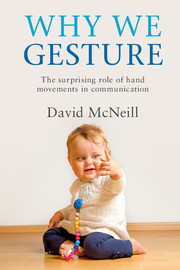Book contents
- Frontmatter
- Dedication
- Contents
- List of figures
- List of tables
- Preface
- Acknowledgments
- Part I Gesture-orchestrated speech
- 1 Why we gesture
- 2 The growth point
- 3 New forms of human action
- 4 Orchestration and unpacking
- 5 Mimicry and metaphor
- Part II Phylogenesis, ontogenesis, brain
- Part III The last page
- References
- Index
2 - The growth point
from Part I - Gesture-orchestrated speech
Published online by Cambridge University Press: 05 December 2015
- Frontmatter
- Dedication
- Contents
- List of figures
- List of tables
- Preface
- Acknowledgments
- Part I Gesture-orchestrated speech
- 1 Why we gesture
- 2 The growth point
- 3 New forms of human action
- 4 Orchestration and unpacking
- 5 Mimicry and metaphor
- Part II Phylogenesis, ontogenesis, brain
- Part III The last page
- References
- Index
Summary
The growth point or GP is the minimal gesture–speech unit in Vygotsky's (1987) sense of a unit opposed to an element. It is the core of its individual utterance, a “new” gesture-action unified with some linguistic content (word or words), which the speaker inhabits. Table 2.1 shows how, in a GP, a meaning is simultaneously cast in opposite semiotic modes. This opposition, or dual semiosis, creates the conditions for a dialectic and is the engine driving language and thought forward in social and mental life. In a nutshell: when we see a gesture and the co-expressive speech with which it synchronizes, we see a dynamic unit of speech and thought. Combining the dynamic and static, the GP becomes the minimal unit of the dynamic dimension itself. This is the nexus at which the static and dynamic dimensions cross, and in forming a GP they have equal weight.
It is called a growth point because it is meant to be the initial pulse of thinking-for-speaking from which a dynamic process of organization emerges (see McNeill and Duncan 2000). Growth begins with a unification of a gesture with some linguistically encoded information. Neither speech nor gesture is the “source.” The imagery in the gesture is visuospatial-actional. It is not photographic. As Table 2.1 shows, this imagery is global-synthetic and non-combinatoric. The linguistic component categorizes this imagery. Linguistic categorization is important since it brings the imagery into the system of language. Gesture is important since it grounds the linguistic categories in an imagery frame. The gesture image provides the GP with the property of “chunking,” a hallmark of expert performance (see Chase and Ericsson 1981). A chunk of linguistic output (not necessarily a grammatical chunk) is organized around the presentation of the image. It is the source of gesture–speech orchestration. Synchronized speech and gesture is the key to this theoretical unit.
The GP is shaped, as Michael Silverstein (2003, p. 195) makes clear in another context, not by causes flowing through it but by a “complex and mediated absorption of indexically linked values and presuppositions.” The GP is in a middle zone where its basic factors are not understood as causes and effects.
- Type
- Chapter
- Information
- Why We GestureThe Surprising Role of Hand Movements in Communication, pp. 21 - 37Publisher: Cambridge University PressPrint publication year: 2015



